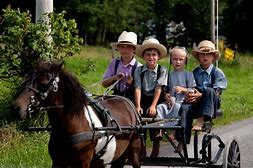Posted on April 28, 2020 in Amish History
and by Erik Wesner on AmishAmerica.com
(Click on link for original reader comments)
adapted here by Larry Pearce on May 5, 2020
(*Click on this to see how we are related to this family)
Read Part 1 here
Let’s pick back up with five more common Amish names. I used your suggestions from earlier post comments to put together this list. If there are other names you’d like to see, let us know in the comments here. I’ll do at least one more edition of these posts, possibly more.
These histories are excerpted from “Amish and Mennonite Family Names”, a series of articles by Amish writer Joseph Stoll, which ran in Family Life from December 1968 to March 1969. I’ve added some additional information below in italics where relevant.
1. Zook – The Zook family were originally from Signau in the Swiss canton of Bern. Caspar Zougck was one of the Anabaptist speakers at the Bern Debate of 1538. Uli Zougg, a preacher in the canton of Bern, was imprisoned in 1644. Hans Zoug was a noted Anabaptist minister in Switzerland who endured much persecution. Three of his grandsons, the brothers Christian, Moritz, and Johannes Zug, arrived in Philadelphia in 1742, and became the ancestors of the many Zooks in our churches today.

Somerset County, PA
By 1942, two hundred years after their arrival in Philadelphia, these three brothers were believed to have had about 25,000 descendants. Many of these are Quakers, or belong to some other religious belief other than Amish or Mennonite. It’s interesting to see how this name appeared in its various forms over time: Zougck – Zougg – Zoug – Zug – Zook. A member of a Zook family I am friends with once showed me a piece of paper tracing his family’s roots back around ten generations, to Mifflin County, PA. The earlier ancestors still used the Zug spelling, the first of whom I believe was one of the brothers mentioned above.
2. Gingerich – A fairly common name in Germany, Gingerich first entered Anabaptist records in 1692 when Preacher Christian Guengerich escaped from the prison in Schwarzenegg, where he had been placed because of his religious beliefs. In 1831 Johannes Gingerich (born 1781) and his family and his brother Daniel were given a letter or recommendation by a Hesse state official, who wished them happiness in America. A great-grandson, Pre. John C. Gingerich of Arthur, Ill., still has the original passports and some letters regarding this group.

In 1833 Daniel P. Güngerich of Waldeck brought his family to America, settling first in Somerset County, Pennsylvania, then going on to pioneer the new settlement near Kalona, Iowa. His son, S.D. Guengerich, was a well-known Amish writer. He helped found the “Herold der Wahrheit”, and compiled the Liedersammlung (G), a songbook in use today in some Amish communities.
3. Troyer – One of the very first Swiss Anabaptist martyrs was Hans Dreier, who was drowned in Bern on July 8, 1529, along with two other Anabaptists. When he was questioned before the court, he explained the points of his faith – he held fast to believers’ baptism, did not think it was right to swear oaths, did not believe true Christians would let others suffer want.
Jacob Treyer was an Anabaptist of Laufen, Switzerland. In 1529 he was put in neck irons and brought to the market place of Basel. There a crowd of spectators soon gathered. Jakob boldly spoke to them concerning repentance and the new life. However, when some time later he was sentenced to death by beheading, he cast himself at the feet of the judges and begged for mercy. Because he recanted, he was pardoned.

Beginning about 1733 some Treyers from Bern moved to Pennsylvania, settling in Berks County. These were all Amish. By 1752 the brothers Michael and Andreas Troyer were listed as members of the Northkill Amish congregation in Berks County. In later years the Troyers spread westward, and today they are one of the most numerous Amish families. Bishop David A. Treyer of Holmes County was an influential Amish bishop during the second half of the nineteenth century. He wrote the booklet, “Hinterlassende Schriften”, which was first published in 1920.
John Troyer, who lived near Kokomo, Indiana, had an unusually large family, perhaps the largest of all time among the Amish or Mennonites. John was first married to Catherine Schrock who bore him twelve children. Following her death he married her cousin Caroline (Schrock) Kendall, a young widow with two children. John and Caroline in turn had seventeen additional children. This made a total of 31 children.
4. King – Among the early immigrant settlers were Christian and Samuel Koenig who migrated from Germany to eastern Pennsylvania in 1753. The name was found in the Palatinate census lists as early as 1717, when Hans Koenig was registered in the district of Alzey.

Halifax County, VA
On Dec. 22, 1744, Jacob, Christian, and Samuel König arrived in Philadelphia from Rotterdam. Between 1732 and 1806, 38 persons bearing the name König arrived in Philadelphia. It is not known how many of these were Amish or Mennonite. The name King is today found among the Amish mainly in Lancaster County, Pennsylvania. I would add that the name is also found in Lancaster daughter settlements like Wayne and Parke Counties in Indiana or other Pennsylvania communities such as Dauphin County. It’s also found among Delaware Amish churches.
5. *Lehman – An Anabaptist name originating in the Emmental, canton of Bern, Switzerland. The name means a person living on a gentle slope (Lehn). Near Langnau there is a farm named Lehn.

Wilhelm Lehman of the Emmental was imprisoned in October, 1566 because he refused to takethe oath of allegiance. He was sentenced to death by the sword, but after eleven anxious days of waiting for the execution, he recanted and was released. Hans Lehman landed in Philadelphia on Sept. 27, 1727 and settled in Lancaster County. Hans first settled in Lancaster County, but Amish Lehmans are today more commonly found in northern Indiana. Though the well-known retail store Lehman’s is associated with the Holmes/Wayne County community, there are few Amish Lehmans in that area today.
Read Part 1 here
Read Part 3 here
Read Part 4 here
Last revised 6/18/20

